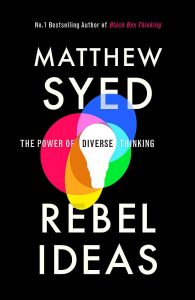
Principles introduced by Matthew Syed-
1. Lack Of Diversity = Collective Blindness:
- Traditionally we think of success in terms of the individual. This may be true sometimes, but for the most part, success is driven by complex systems operating efficiently.
- To solve today’s problems, we need to take a step back and observe the holistic perspective and the value of working with others.
- Most of the challenging work today is undertaken in groups due to the fact that most problems are too complex to solve by oneself.
- The key is to work with people who have different perspectives.
- Intricate problems usually depend on various layers of perspectives. A more diverse team has a greater range of potentially viable options for approaching the problem.
2. Rebels versus Clones:
- Teams need to be diversified, everyone will bring something new to a team. It’s about minds thinking differently. This will create innovative ideas which should be considered, even if not implemented.
- Keeping a wider spectrum of perspectives allows fewer blind spots. Cognitive diversity is going to become a fundamental source of competitive advantage.
- Cognitively diverse teams are not like clones, they do not mirror the same view, they have perspectives that challenge, alter and diverge conventional ideas.
3. Cognitive Dissent:
- Simple decisions which need to be made instantly, dominant individuals are generally the most effective method. However, modern problems are best solved through collaboration and collective intelligence.
- ‘Rebel ideas’ can be regarded as threats in a hierarchical structure, and are likely going to be rejected. Conventional meetings can cause these issues.
- If a team’s progress depends on pulling others down to get ahead, it then opens the door to politics, backstabbing and constant vigilance.
- Instead of doing away with a hierarchical structure, Syed presents a new type of trait a leader should exhibit called prestige. These are individuals who achieve influence and control without engaging in shows of dominance.
- People who exhibit prestige share knowledge and are willing to teach others.
4. Innovation:
- Syed suggests there are two types of innovation: Marginal, which means constantly improving on what you already have and Recombinant where you take two ideas from different domains which are unrelated and combine them together.
- With diverse opinions and disciplines involved, you can view the idea from the outside with a wider perspective.
5. Echo Chambers:
- Echo chambers are places where we interact with people with similar interests and values. Places where our beliefs are regularly repeated by the people around us in person or online.
- Echo chambers weaken trust in alternative views. Therefore obtaining trust with people of opposing views enables us to be more open to the idea instead of denying its credibility.
6. Beyond Average:
- Focusing on averages can be misleading. When complicated systems are involved, there is no such thing as a perfect average.
- Standardisation is where people focus their efforts, but this should be the opposite.
- There are some scenarios where people must fit the role, but we focus on moving towards adopting others uniqueness instead of trying to take it away from them.
# Key Takeaways:
– Diverse perspectives and backgrounds lead to better decision-making and problem-solving.
– Cognitive diversity is just as important as demographic diversity.
– Cognitive diversity can be fostered through creating a safe environment for dissent and encouraging different ways of thinking.
– The “rebel ideas” that challenge the status quo are often the most valuable and innovative.
– Embracing uncertainty and being open to change is crucial for success in a rapidly changing world.
# Practical Application:
– Encourage diversity in teams and actively seek out different perspectives.
– Create a culture where dissent is welcomed and encouraged.
– Embrace uncertainty and be open to change, rather than sticking to traditional ways of thinking.
– Actively seek out and consider “rebel ideas” that challenge the status quo.
# Valuable Insights for Leaders/Managers:
– Chapter 3: “The Power of Cognitive Diversity”
– highlights the importance of cognitive diversity and how it can be fostered in teams.
– Chapter 4: “The Power of Cognitive Friction”
– discusses the benefits of having dissent and disagreement in decision-making processes.
– Chapter 6: “The Power of the Outsider”
– explores the value of bringing in outsiders and diverse perspectives to solve problems and drive innovation.
# Case Studies/Examples:
– The story of the CIA’s “Red Cell” team, which was created to challenge the agency’s thinking and provide alternative perspectives.
– The success of Pixar’s diverse and collaborative team in creating groundbreaking animated films.
– The use of “red teaming” in the military to simulate different scenarios and challenge traditional thinking.
Leave a Reply